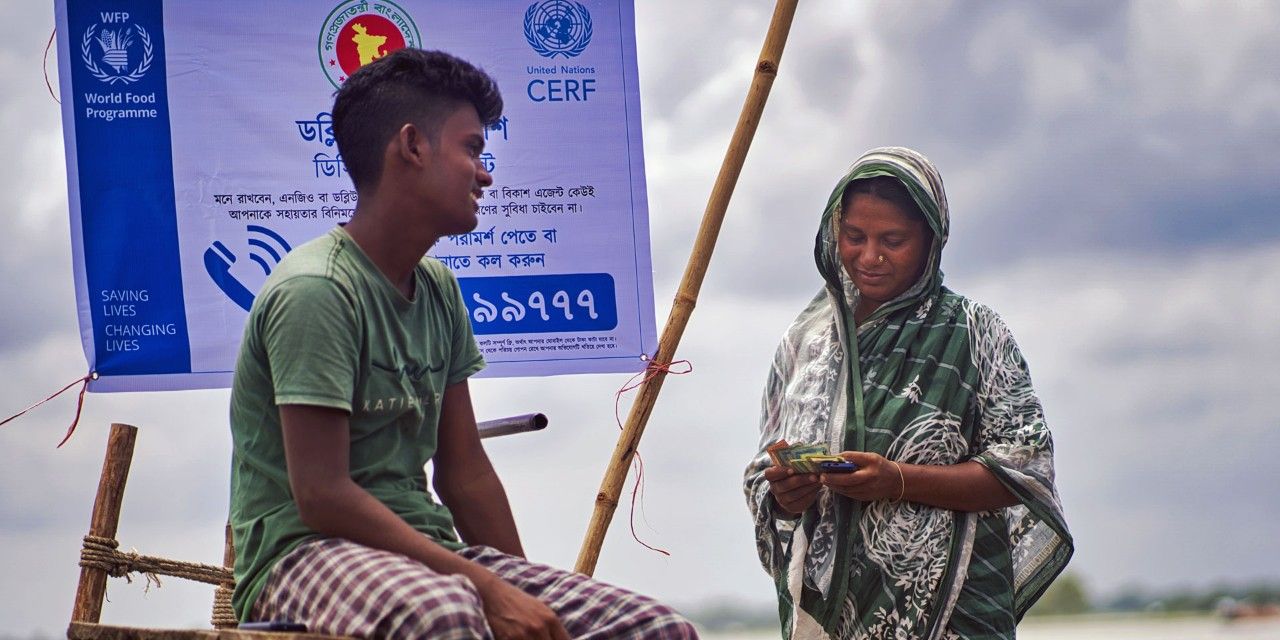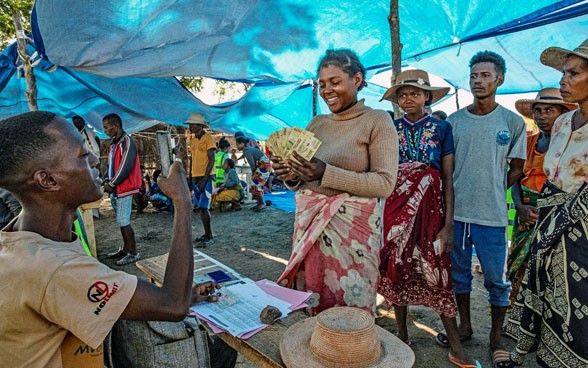Ready for anything: how Anticipatory Action is saving lives
Climate extremes are a key driver of food insecurity. More frequent and intense floods, droughts and storms account for up to 90 per cent of hazards worldwide. At the same time, the climate crisis is intersecting with and exacerbating other drivers of hunger, including conflict and economic downturns. Traditional humanitarian response systems need to evolve from crisis response to forward-looking risk management, and the SDC-co-funded World Food Programme's Anticipatory Action (AA) is one way to achieve this.

When flash floods swept through the village of Beletweyne in central Somalia, Bashir Abdi and his family were prepared. Thanks to the World Food Programme's (WFP) Anticipatory Action (AA) programme, they had received vital funds and information in advance. «The warnings were life-saving,» says Bashir Abdi, one of the 700,000 people forced from their homes by deadly floods in Somalia. «We were told everything: what to do, where to go, and to collect essential household items. And the cash vouchers helped.»
AA enables humanitarian actors, governments and communities to take predefined steps in advance of predicted hazards to prevent or mitigate acute humanitarian impacts before they fully unfold. This proactive approach is transforming humanitarian aid, leveraging advances in early warning systems, and empowering communities and governments to respond to crises before they occur. In 2023, the WFP's AA operations reached 4.1 million people in 36 countries, significantly reducing the impact of droughts, floods, cyclones and other disasters thanks to USD 61.5 million of prearranged financing, including contributions from the Swiss government .
2023 was a record-breaking year for climate extremes, resulting in increased food insecurity for millions of people. Against this backdrop, the WFP's AA operations have been able to provide a lifeline through a proactive and dignity-centred approach to disaster management, as seen across Asia, Africa, and Latin America. When forecasts for the 2023 El Niño season emerged in early 2023, the WFP acted swiftly. In the Horn of Africa, it fast-tracked local flood-focused AA plans in anticipation of heavy rains, delivering early warning messages and anticipatory cash to 442,209 people in Somalia days before floods devastated a number of areas. Similarly, in Southern Africa, the WFP used El Niño forecasts and local data to support AA in Lesotho, Madagascar, Mozambique, and Zimbabwe, providing USD 14 million to help 1.25 million people prepare for anticipated droughts.

Reducing the impact of floods in Bangladesh
In Bangladesh, monsoon floods can wreak havoc on communities, but AA plans have made a world of difference. Since 2015, the WFP has been working with the government of Bangladesh, the Bangladesh Red Crescent Society (BDRCS), and the Red Cross Red Crescent Climate Centre (RCCC) to develop and implement anticipatory assistance before severe weather events. Long before the monsoon season begins, the WFP and its partners approve AA plans, then jointly monitor flood and cyclone forecasts, and prepare to deliver cash transfers, early warning alerts, and pre-positioned supplies days before a cyclone or flood hits.
A shining example of this approach took place in July 2020. Faced with one of the worst floods on record, the WFP and its partners moved quickly. Four days before the floodwaters peaked, they sent Bangladeshi Taka (BDT) 4,500 (about USD 53) via mobile money to each vulnerable household along the Jamuna River. This cash assistance, equivalent to two weeks' worth of food, reached around 145,000 people.

An independent evaluation found that households receiving these cash transfers were 36 per cent less likely to go without food for a day during the flood. Three months later, these households reported increased food consumption, improved well-being, reduced asset loss, and increased earning potential. They also took more preparatory actions, such as evacuating family members and livestock, resulting in lower losses.
Was it cheaper? According to the UN Office for the Coordination of Humanitarian Affairs (OCHA), the 2020 AA reached more people at half the per capita cost – USD 13 versus USD 26 – and nearly 100 days faster than the Central Emergency Response Fund (CERF)-funded rapid response funds disbursed after the 2019 floods in Bangladesh. Anticipating crises makes it possible to help more people faster with the same amount of money.
Yet challenges remain. Accurate and timely forecasts are vital, but difficult to provide without the help of early warning systems. Coordination with local authorities and community participation also require ongoing effort and resources. Despite these hurdles, the partnership between the WFP, regional climate centres, local and national governments, and community organisations has been instrumental in ensuring AA's effectiveness.
Partnership for success
The WFP works with a wide range of organisations, including UN agencies, local governments, the private sector, and NGOs, to increase the reach and impact of AA and early warning systems. The recently published joint WFP–FAO anticipatory action strategy sets out in concrete terms how these partnerships can boost the collective reach of humanitarian aid. This collaboration dovetails with emergency response, resilience-building, and social protection programmes to enable cost-effective integrated risk management approaches to a changing climate.
While challenges remain, the collaborative efforts of the WFP, its supporters such as the Swiss Agency for Development and Cooperation, and partner governments highlight AA's potential to reduce the impact of predictable crises and help prevent and minimise loss and harm to lives, livelihoods and food systems. With continued investment and partnership, AA can shape the future of humanitarian aid and save more lives.
World Food Programme
The World Food Programme (WFP) is one of Switzerland's priority multilateral partners. As the world's largest humanitarian organisation, it provided food aid to over 152 million people in 2023. Through its contribution to the WFP's Anticipatory Action programme, Switzerland supports and promotes innovative approaches that make humanitarian action more effective, saving more lives, strengthening local capacities, and taking into account the impact of climate change.
Contact
Eichenweg 5
3003 Bern

